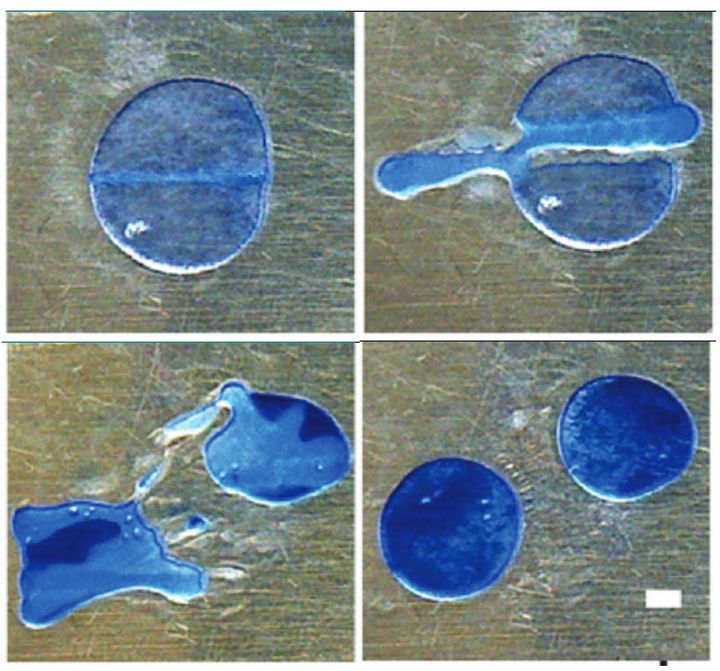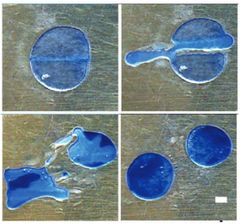Material science advance could lead to airplanes that optimize their shape in flight
Materials and objects could take on different shapes by themselves through a method developed at KTH Royal Institute of Technology. Breakthrough tests showed how microscale melting and cooling of a wide range of materials—such as plastics and metals—can be manipulated to reorganize their mass and form new shapes.

Materials and objects could take on different shapes by themselves through a method developed at KTH Royal Institute of Technology. Breakthrough tests showed how microscale melting and cooling of a wide range of materials—such as plastics and metals—can be manipulated to reorganize their mass and form new shapes.
Performed in 2D with paraffin as the test material, the study introduces a new path for development of materials that can be programmed to shapeshift in 3D autonomously, says Professor Wouter van der Wijngaart, a researcher in the Division of Micro and Nanosystems at KTH Royal Institute of Technology in Stockholm.
With the new technology the researchers envision limitless possibilities, from cars and airplanes that constantly adjust their form to optimize drag, to meeting rooms where the required seating is generated on demand.
“This could enable limitless on-the-fly creation of tools and other objects, without introducing additional materials,” van der Wijngaart says.
The method relies on a laser to melt and shift material, bit by bit, so that it moves from one side of the object to another.
“Everything is just shifted a few tens of micrometers during each cycle,” van der Wijngaart says. “It can reshape objects to pass through narrow gaps and reconstitute them into any target shape.”
The repetition of this phase-shift ultimately reshapes the material into any form desired, with greater freedom of shape and spatial resolution than other techniques today, he says. Integrating the heating mechanism inside actuals object will enable them to shapeshift autonomously.
He says that this breakthrough in material science and engineering “could lead to advancements in that were once deemed impossible.”
Publishing in Advanced Functional Materials, the researchers released a video showing three blobs of paraffin transforming themselves to form the university’s acronymic brand name, KTH”.
The project, Robotic Matter, is funded by Digital Futures. The study’s co-authors were Kerem Kaya, Alexander Kravberg, Claudia Scarpellini, Emre Iseri, Danica Kragic and van der Wijngaart.
###
Programmable Matter with Free and High-Resolution Transfiguration and Locomotion
Advanced Functional Materials
https://doi.org/10.1002/adfm.202307105
Images

Subscribe to releases from KTH Royal Institute of Technology
Subscribe to all the latest releases from KTH Royal Institute of Technology by registering your e-mail address below. You can unsubscribe at any time.
Latest releases from KTH Royal Institute of Technology
AI helps decode horses' body language for better veterinary care9.4.2025 12:20:55 CEST | Press Release
Researchers are using AI to bridge the communication gap between horse and human. Combining 3D motion capture and machine learning, a new modeling system would equip veterinarians with a powerful visual tool for interpreting equine body language—the key to detecting physical and even behavioral problems.
New Swedish Initiative to Integrate Research and Healthcare4.4.2025 11:37:56 CEST | Press Release
A groundbreaking national initiative, Precision Omics Initiative Sweden (PROMISE), aims to connect research with healthcare and establish Sweden as a world leader in data-driven precision medicine.
For graphene production, a potential green alternative to mining graphite3.3.2025 14:14:40 CET | Press Release
Researchers in Sweden report a green alternative to reduce reliance on mining graphite, the raw source behind the "wonder material" graphene.
AI on aircraft can help prevent stalls and terrifying drops in altitude17.2.2025 15:58:14 CET | Press Release
Artificial intelligence could help prevent terrifying mid-air drops in altitude. In a new study, an international research team successfully tested a machine learning system for preventing trouble with turbulence.
Alternative to studded winter tires reduces airborne particles by 20 percent6.2.2025 14:41:07 CET | Press Release
On icy roads, studded winter tires can save lives – but they pulverize pavement and fill the air with dangerous, inhalable particles. A new Swedish study shows that both road wear and airborne particles could be reduced by as much as 20 percent if studs were made instead with an alternative hard metal.
In our pressroom you can read all our latest releases, find our press contacts, images, documents and other relevant information about us.
Visit our pressroom